wheel size MINI Clubman 2010 Owner's Manual
[x] Cancel search | Manufacturer: MINI, Model Year: 2010, Model line: Clubman, Model: MINI Clubman 2010Pages: 160, PDF Size: 2.58 MB
Page 66 of 160
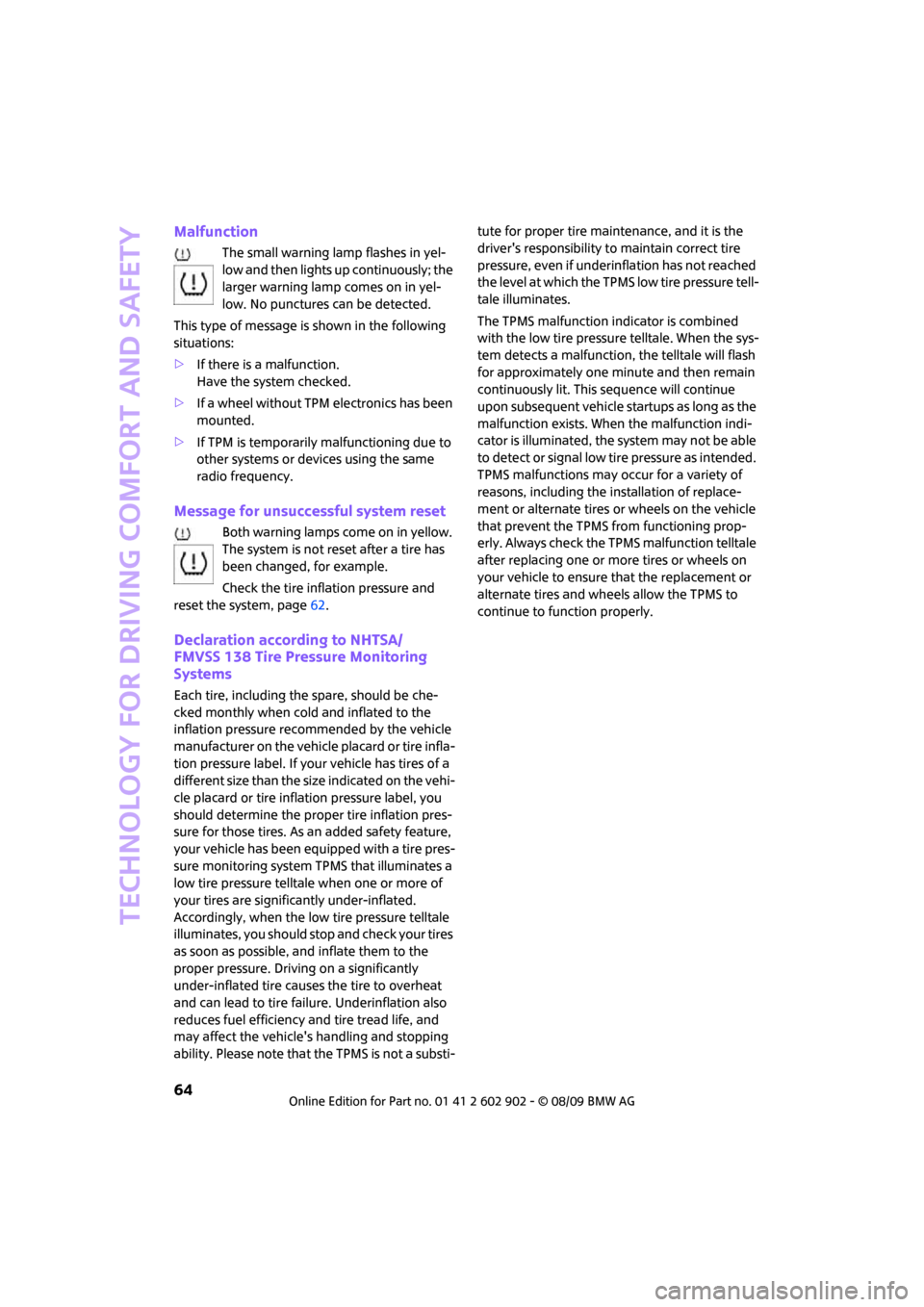
Technology for driving comfort and safety
64
Malfunction
The small warning lamp flashes in yel-
low and then lights up continuously; the
larger warning lamp comes on in yel-
low. No punctures can be detected.
This type of message is shown in the following
situations:
>If there is a malfunction.
Have the system checked.
>If a wheel without TPM electronics has been
mounted.
>If TPM is temporarily malfunctioning due to
other systems or devices using the same
radio frequency.
Message for unsuccessful system reset
Both warning lamps come on in yellow.
The system is not reset after a tire has
been changed, for example.
Check the tire inflation pressure and
reset the system, page62.
Declaration according to NHTSA/
FMVSS 138 Tire Pressure Monitoring
Systems
Each tire, including the spare, should be che-
cked monthly when cold and inflated to the
inflation pressure recommended by the vehicle
manufacturer on the vehicle placard or tire infla-
tion pressure label. If your vehicle has tires of a
different size than the size indicated on the vehi-
cle placard or tire inflation pressure label, you
should determine the proper tire inflation pres-
sure for those tires. As an added safety feature,
your vehicle has been equipped with a tire pres-
sure monitoring system TPMS that illuminates a
low tire pressure telltale when one or more of
your tires are significantly under-inflated.
Accordingly, when the low tire pressure telltale
illuminates, you should stop and check your tires
as soon as possible, and inflate them to the
proper pressure. Driving on a significantly
under-inflated tire causes the tire to overheat
and can lead to tire failure. Underinflation also
reduces fuel efficiency and tire tread life, and
may affect the vehicle's handling and stopping
ability. Please note that the TPMS is not a substi-tute for proper tire maintenance, and it is the
driver's responsibility to maintain correct tire
pressure, even if underinflation has not reached
the level at which the TPMS low tire pressure tell-
tale illuminates.
The TPMS malfunction indicator is combined
with the low tire pressure telltale. When the sys-
tem detects a malfunction, the telltale will flash
for approximately one minute and then remain
continuously lit. This sequence will continue
upon subsequent vehicle startups as long as the
malfunction exists. When the malfunction indi-
cator is illuminated, the system may not be able
to detect or signal low tire pressure as intended.
TPMS malfunctions may occur for a variety of
reasons, including the installation of replace-
ment or alternate tires or wheels on the vehicle
that prevent the TPMS from functioning prop-
erly. Always check the TPMS malfunction telltale
after replacing one or more tires or wheels on
your vehicle to ensure that the replacement or
alternate tires and wheels allow the TPMS to
continue to function properly.
Page 98 of 160
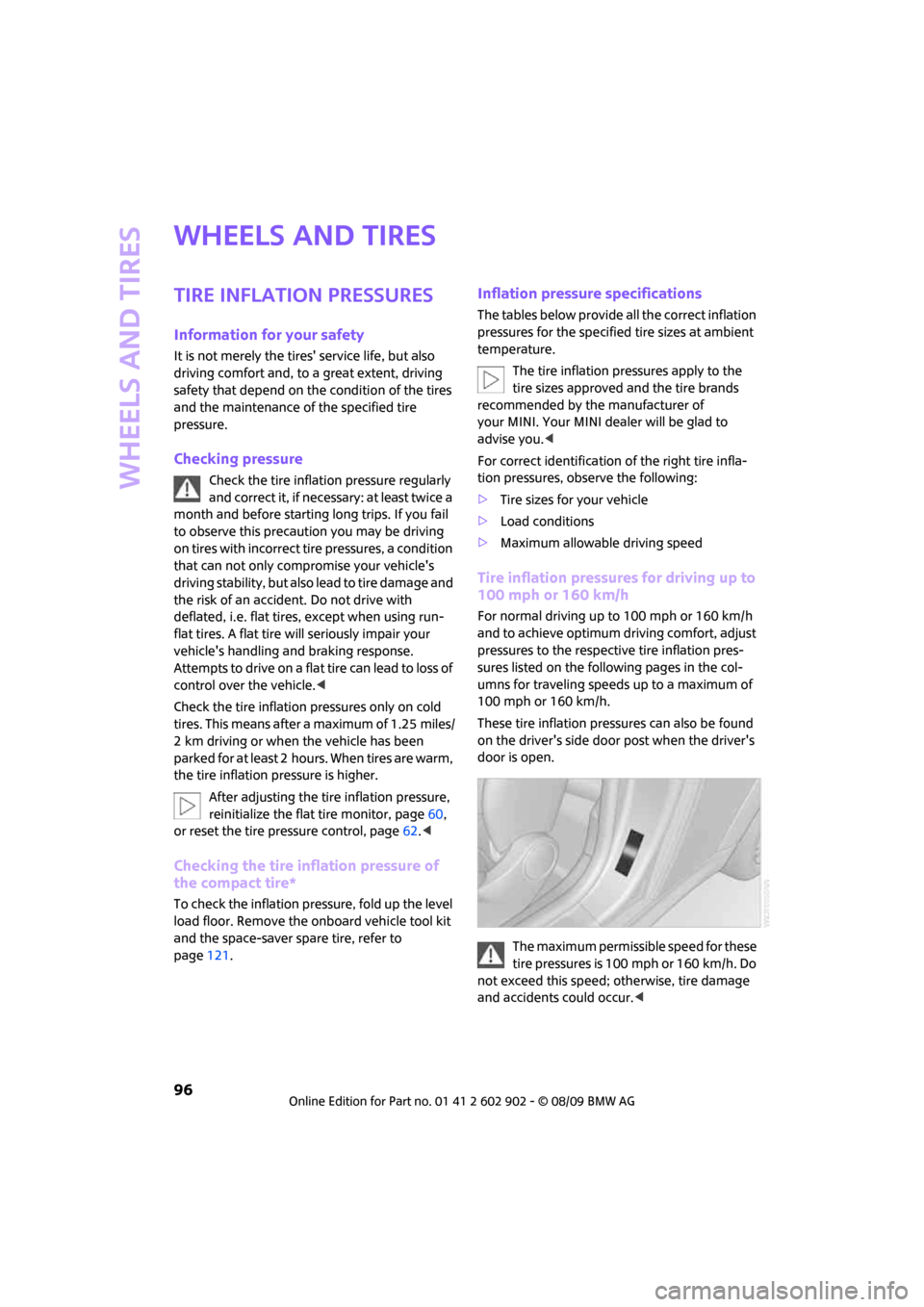
Wheels and tires
96
Wheels and tires
Tire inflation pressures
Information for your safety
It is not merely the tires' service life, but also
driving comfort and, to a great extent, driving
safety that depend on the condition of the tires
and the maintenance of the specified tire
pressure.
Checking pressure
Check the tire inflation pressure regularly
and correct it, if necessary: at least twice a
month and before starting long trips. If you fail
to observe this precaution you may be driving
on tires with incorrect tire pressures, a condition
that can not only compromise your vehicle's
driving stability, but also lead to tire damage and
the risk of an accident. Do not drive with
deflated, i.e. flat tires, except when using run-
flat tires. A flat tire will seriously impair your
vehicle's handling and braking response.
Attempts to drive on a flat tire can lead to loss of
control over the vehicle.<
Check the tire inflation pressures only on cold
tires. This means after a maximum of 1.25 miles/
2 km driving or when the vehicle has been
parked for at least 2 hours. When tires are warm,
the tire inflation pressure is higher.
After adjusting the tire inflation pressure,
reinitialize the flat tire monitor, page60,
or reset the tire pressure control, page62.<
Checking the tire inflation pressure of
the compact tire*
To check the inflation pressure, fold up the level
load floor. Remove the onboard vehicle tool kit
and the space-saver spare tire, refer to
page121.
Inflation pressure specifications
The tables below provide all the correct inflation
pressures for the specified tire sizes at ambient
temperature.
The tire inflation pressures apply to the
tire sizes approved and the tire brands
recommended by the manufacturer of
your MINI. Your MINI dealer will be glad to
advise you.<
For correct identification of the right tire infla-
tion pressures, observe the following:
>Tire sizes for your vehicle
>Load conditions
>Maximum allowable driving speed
Tire inflation pressures for driving up to
100 mph or 160 km/h
For normal driving up to 100 mph or 160 km/h
and to achieve optimum driving comfort, adjust
pressures to the respective tire inflation pres-
sures listed on the following pages in the col-
umns for traveling speeds up to a maximum of
100 mph or 160 km/h.
These tire inflation pressures can also be found
on the driver's side door post when the driver's
door is open.
The maximum permissible speed for these
tire pressures is 100 mph or 160 km/h. Do
not exceed this speed; otherwise, tire damage
and accidents could occur.<
Page 100 of 160
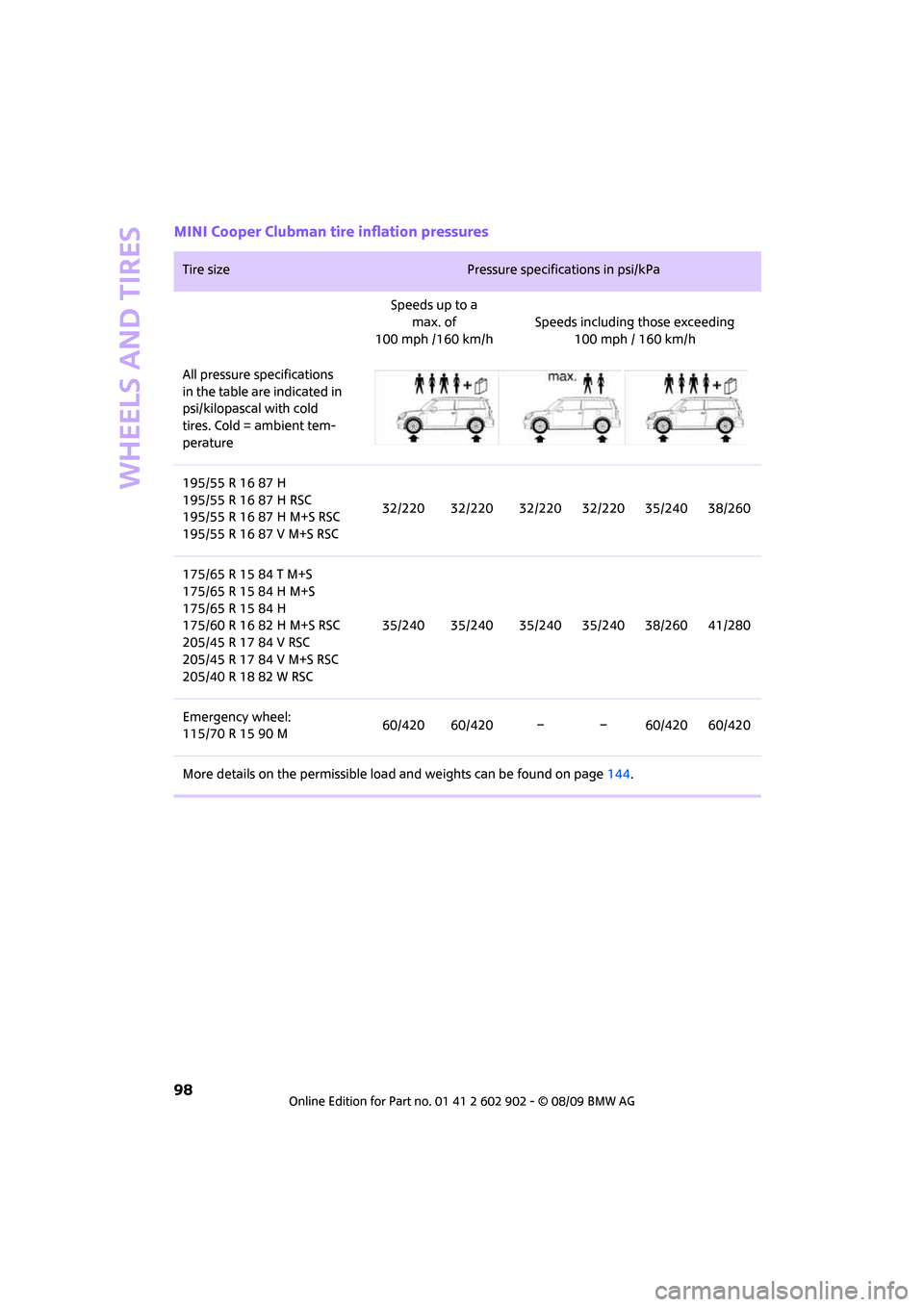
Wheels and tires
98
MINI Cooper Clubman tire inflation pressures
Tire size Pressure specifications in psi/kPa
Speeds up to a
max. of
100 mph /160 km/hSpeeds including those exceeding
100 mph / 160 km/h
All pressure specifications
in the table are indicated in
psi/kilopascal with cold
tires. Cold = ambient tem-
perature
195/55 R 16 87 H
195/55 R 16 87 H RSC
195/55 R 16 87 H M+S RSC
195/55 R 16 87 V M+S RSC32/220 32/220 32/220 32/220 35/240 38/260
175/65 R 15 84 T M+S
175/65 R 15 84 H M+S
175/65 R 15 84 H
175/60 R 16 82 H M+S RSC
205/45 R 17 84 V RSC
205/45 R 17 84 V M+S RSC
205/40 R 18 82 W RSC35/240 35/240 35/240 35/240 38/260 41/280
Emergency wheel:
115/70 R 15 90 M60/420 60/420 – – 60/420 60/420
More details on the permissible load and weights can be found on page144.
Page 102 of 160
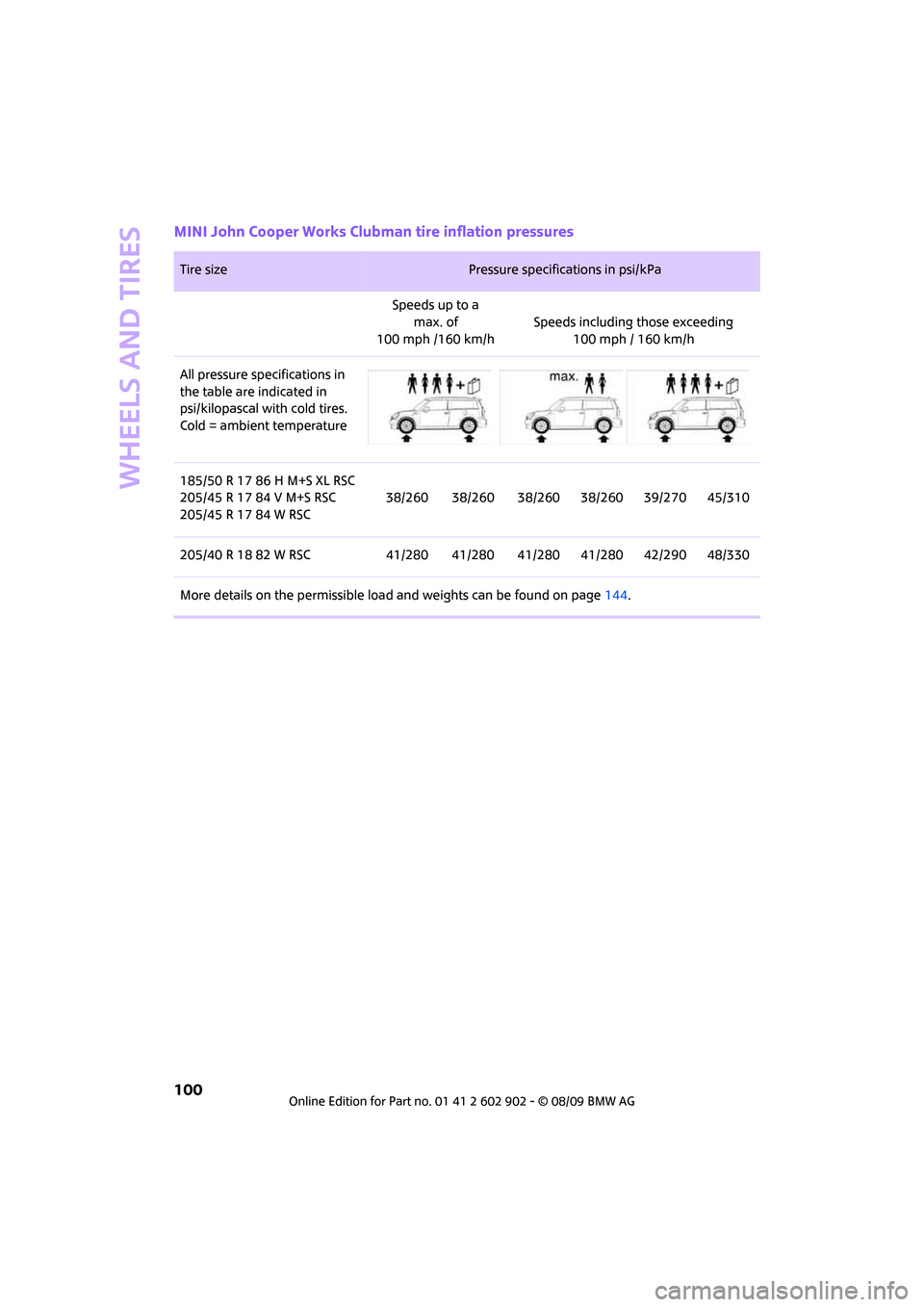
Wheels and tires
100
MINI John Cooper Works Clubman tire inflation pressures
Tire size Pressure specifications in psi/kPa
Speeds up to a
max. of
100 mph /160 km/hSpeeds including those exceeding
100 mph / 160 km/h
All pressure specifications in
the table are indicated in
psi/kilopascal with cold tires.
Cold = ambient temperature
185/50 R 17 86 H M+S XL RSC
205/45 R 17 84 V M+S RSC
205/45 R 17 84 W RSC38/260 38/260 38/260 38/260 39/270 45/310
205/40 R 18 82 W RSC 41/280 41/280 41/280 41/280 42/290 48/330
More details on the permissible load and weights can be found on page144.
Page 103 of 160
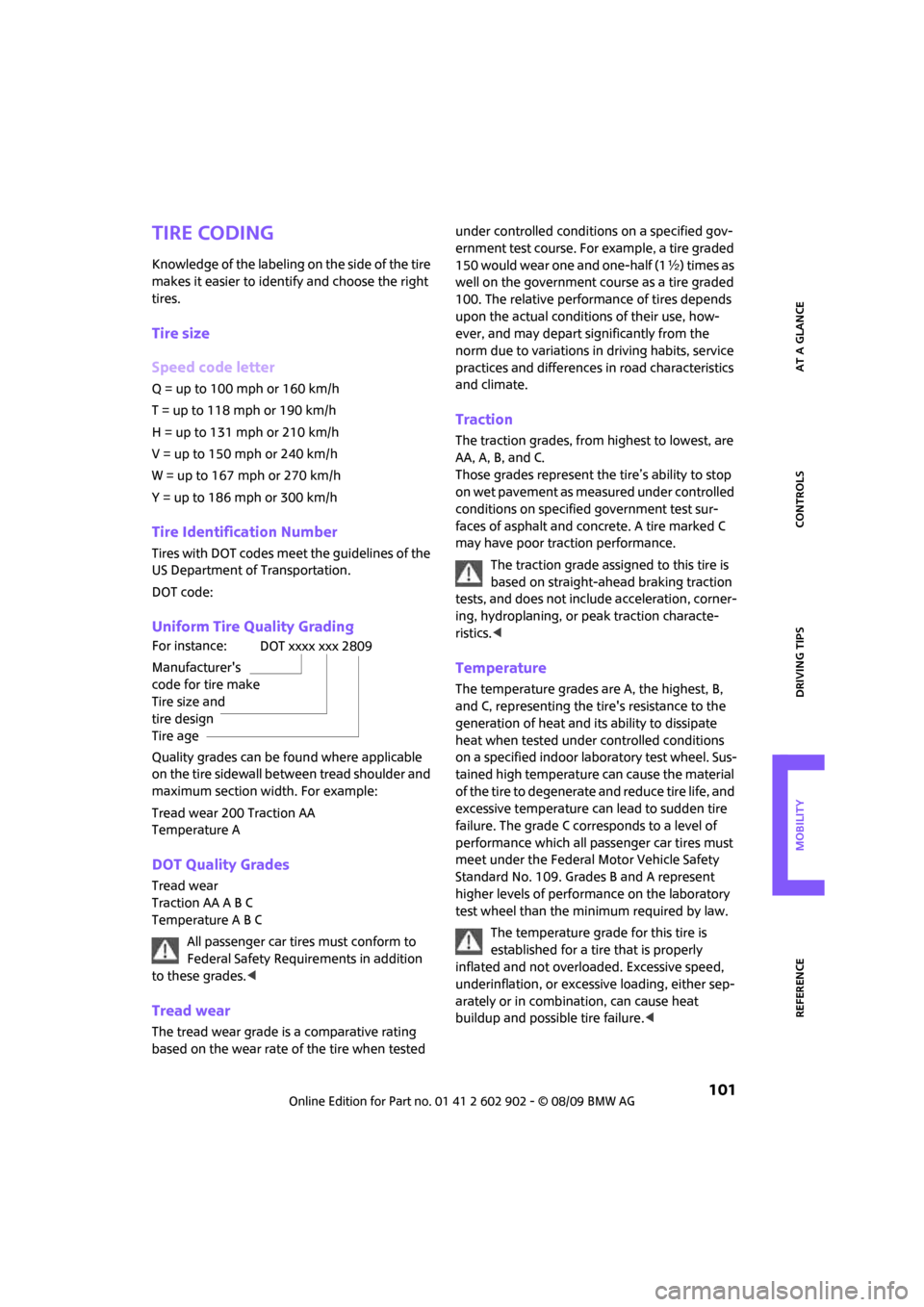
REFERENCEAT A GLANCE CONTROLS DRIVING TIPS MOBILITY
101
Tire coding
Knowledge of the labeling on the side of the tire
makes it easier to identify and choose the right
tires.
Tire size
Speed code letter
Q = up to 100 mph or 160 km/h
T = up to 118 mph or 190 km/h
H = up to 131 mph or 210 km/h
V = up to 150 mph or 240 km/h
W = up to 167 mph or 270 km/h
Y = up to 186 mph or 300 km/h
Tire Identification Number
Tires with DOT codes meet the guidelines of the
US Department of Transportation.
DOT code:
Uniform Tire Quality Grading
Quality grades can be found where applicable
on the tire sidewall between tread shoulder and
maximum section width. For example:
Tread wear 200 Traction AA
Temperature A
DOT Quality Grades
Tread wear
Traction AA A B C
Temperature A B C
All passenger car tires must conform to
Federal Safety Requirements in addition
to these grades.<
Tread wear
The tread wear grade is a comparative rating
based on the wear rate of the tire when tested under controlled conditions on a specified gov-
ernment test course. For example, a tire graded
150 would wear one and one-half (1γ) times as
well on the government course as a tire graded
100. The relative performance of tires depends
upon the actual conditions of their use, how-
ever, and may depart significantly from the
norm due to variations in driving habits, service
practices and differences in road characteristics
and climate.
Traction
The traction grades, from highest to lowest, are
AA, A, B, and C.
Those grades represent the tire’s ability to stop
on wet pavement as measured under controlled
conditions on specified government test sur-
faces of asphalt and concrete. A tire marked C
may have poor traction performance.
The traction grade assigned to this tire is
based on straight-ahead braking traction
tests, and does not include acceleration, corner-
ing, hydroplaning, or peak traction characte-
ristics.<
Temperature
The temperature grades are A, the highest, B,
and C, representing the tire's resistance to the
generation of heat and its ability to dissipate
heat when tested under controlled conditions
on a specified indoor laboratory test wheel. Sus-
tained high temperature can cause the material
of the tire to degenerate and reduce tire life, and
excessive temperature can lead to sudden tire
failure. The grade C corresponds to a level of
performance which all passenger car tires must
meet under the Federal Motor Vehicle Safety
Standard No. 109. Grades B and A represent
higher levels of performance on the laboratory
test wheel than the minimum required by law.
The temperature grade for this tire is
established for a tire that is properly
inflated and not overloaded. Excessive speed,
underinflation, or excessive loading, either sep-
arately or in combination, can cause heat
buildup and possible tire failure.< For instance:
Manufacturer's
code for tire make
Tire size and
tire design
Tire age
DOT xxxx xxx 2809
Page 105 of 160
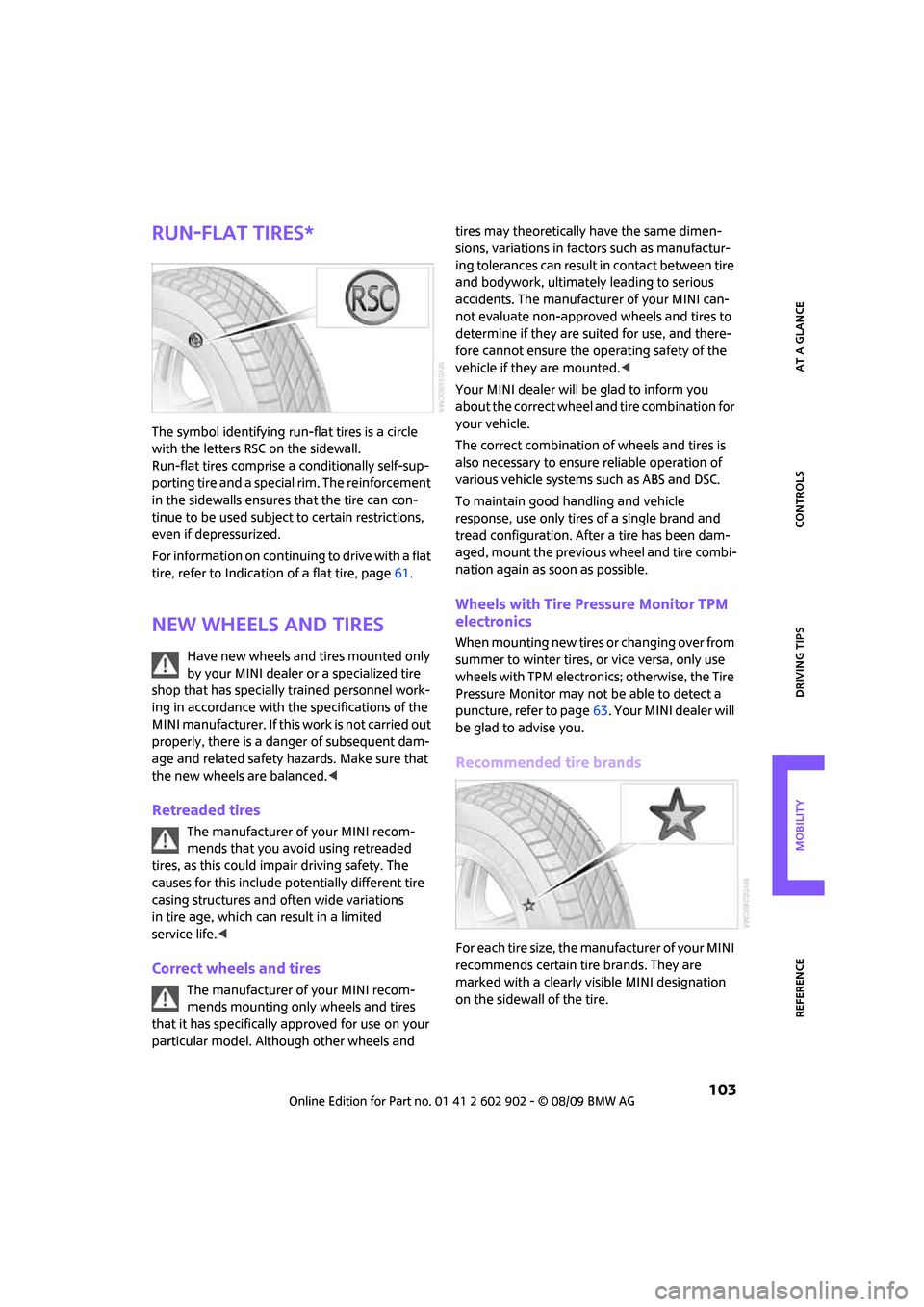
REFERENCEAT A GLANCE CONTROLS DRIVING TIPS MOBILITY
103
Run-flat tires*
The symbol identifying run-flat tires is a circle
with the letters RSC on the sidewall.
Run-flat tires comprise a conditionally self-sup-
porting tire and a special rim. The reinforcement
in the sidewalls ensures that the tire can con-
tinue to be used subject to certain restrictions,
even if depressurized.
For information on continuing to drive with a flat
tire, refer to Indication of a flat tire, page61.
New wheels and tires
Have new wheels and tires mounted only
by your MINI dealer or a specialized tire
shop that has specially trained personnel work-
ing in accordance with the specifications of the
MINI manufacturer. If this work is not carried out
properly, there is a danger of subsequent dam-
age and related safety hazards. Make sure that
the new wheels are balanced.<
Retreaded tires
The manufacturer of your MINI recom-
mends that you avoid using retreaded
tires, as this could impair driving safety. The
causes for this include potentially different tire
casing structures and often wide variations
in tire age, which can result in a limited
service life.<
Correct wheels and tires
The manufacturer of your MINI recom-
mends mounting only wheels and tires
that it has specifically approved for use on your
particular model. Although other wheels and tires may theoretically have the same dimen-
sions, variations in factors such as manufactur-
ing tolerances can result in contact between tire
and bodywork, ultimately leading to serious
accidents. The manufacturer of your MINI can-
not evaluate non-approved wheels and tires to
determine if they are suited for use, and there-
fore cannot ensure the operating safety of the
vehicle if they are mounted.<
Your MINI dealer will be glad to inform you
about the correct wheel and tire combination for
your vehicle.
The correct combination of wheels and tires is
also necessary to ensure reliable operation of
various vehicle systems such as ABS and DSC.
To maintain good handling and vehicle
response, use only tires of a single brand and
tread configuration. After a tire has been dam-
aged, mount the previous wheel and tire combi-
nation again as soon as possible.
Wheels with Tire Pressure Monitor TPM
electronics
When mounting new tires or changing over from
summer to winter tires, or vice versa, only use
wheels with TPM electronics; otherwise, the Tire
Pressure Monitor may not be able to detect a
puncture, refer to page63. Y o u r M I N I d e a l e r w i l l
be glad to advise you.
Recommended tire brands
For each tire size, the manufacturer of your MINI
recommends certain tire brands. They are
marked with a clearly visible MINI designation
on the sidewall of the tire.
Page 123 of 160

REFERENCEAT A GLANCE CONTROLS DRIVING TIPS MOBILITY
121
Changing wheels
Space-saver spare tire*
To change a space-saver spare tire, proceed as
follows:
>Remove the space-saver spare tire,
page121
>Prepare for tire change, page121
>Jack up vehicle, page122
>Mount space-saver spare tire, page122
>Tighten lug bolts, page122
>Drive with space-saver spare tire, page121
Tire change set for a space-saver
spare tire*
In vehicles with the space-saver spare tire, the
tire change set with the onboard vehicle tool kit
is located beneath the floor mat or level load
floor in the cargo bay.
1Folding chock and cover for defective wheel
2Vehicle jack
3Wheel stud wrench
4Hub cover remover
5Flat screwdriver/Phillips screwdriver
6Torx insert bit for screwdriver
7Towing eyelet
The onboard vehicle tool kit includes a pouch
with a plastic bag in which you can place the
damaged wheel.
Removing the space-saver spare tire
The space-saver spare tire is located under the
tire change set in the cargo bay.
1.Fold up the floor mat.
2.Unscrew the nut, arrow, and remove the
space-saver spare tire.
Driving with the space-saver spare tire
Drive cautiously and do not exceed a
speed of 50 mph/80 km/h. Changes may
occur in vehicle handling such as lower track sta-
bility during braking, longer braking distances
and changes in self-steering properties when
close to the handling limit. These properties are
more noticeable with winter tires.<
Only one space-saver spare tire may be
mounted at one time. Mount a wheel and
tire of the original size as soon as possible, to
avoid any safety risks.<
Check the tire inflation pressure at the ear-
liest opportunity and correct it if neces-
sary. Replace the defective tire as soon as possi-
ble and have the new wheel/tire assembly
balanced.<
Preparing for a tire change
Observe the safety precautions regarding
flat tires on page118.<
Additional safety measures when chang-
ing tires:
Only change the tire when parked on a surface
that is level, firm and not slippery.
The vehicle or the jack could slip sideways on
soft or slippery support surfaces, such as snow,
ice, flagstones, etc.
Page 155 of 160

REFERENCEAT A GLANCE CONTROLS DRIVING TIPS MOBILITY
153
Runflat Tyres, refer to Run-flat
tires103
S
Safety belts34
– damage34
– indicator lamp34
– reminder34
– sitting safely31
Safety belts, care112
Safety systems
– airbags65
– Antilock Brake System
ABS58
– Dynamic Stability Control
DSC58
– safety belts34
Safety tires, refer to Run-flat
tires103
Screw thread for tow
fitting126
Seat adjustment
– mechanical32
Seats31
– adjusting the seats32
– heating34
– sitting safely31
Securing the vehicle
– from inside24
– from outside21
Selector lever
– automatic transmission with
Steptronic42
Selector lever lock
– automatic transmission with
Steptronic, refer to
Shiftlock42
– overriding manually44
Selector lever positions
– automatic transmission with
Steptronic42
Service car, refer to Roadside
Assistance124
Service data in the remote
control108Service Interval Display, refer
to Condition Based Service
CBS108
Service, refer to Roadside
Assistance124
Service requirement display,
refer to Condition Based
Service CBS108
Service requirements53
Settings
– clock, 12h/24h mode52
Shifting gears
– automatic transmission with
Steptronic43
– manual transmission42
Shiftlock
– automatic transmission, refer
to Changing selector lever
positions42
Side airbags65
Side door, rear, refer to
Clubdoor25
Side turn signal indicator
– replacing bulb117
Side windows, refer to
Windows30
Signal horn, refer to Horn10
Sitting safely
31
– airbags31
– safety belts31
– with head restraint31
Size, refer to Dimensions143
Sliding/tilt sunroof
– refer to Glass sunroof,
electric29
Slot for remote control40
Smokers' package, refer to
Ashtray81
Snap-in adapter, refer to
Center armrest storage
compartment79
Snow chains104
Socket for Onboard Diagnosis
OBD108
Socket, refer to Connecting
electrical appliances81Space-saver spare tire
– changing tires121
– inflation pressure96
Spare wheel, refer to Space-
saver spare tire121
Special oils, refer to Approved
engine oils107
Speed142
– with winter tires104
Speed control, refer to Cruise
control47
Speedometer12
Split rear seat backrest, refer to
Expanding the cargo bay86
Splitdoor25
– opening from outside26
– unlocking with remote
control23
Sport button60
Stability control, refer to
Driving stability control
systems57
Start/stop button40
– starting the engine41
– switching off the engine41
Starting assistance, refer to
Jump-starting124
Starting, refer to Starting the
engine41
Starting the engine
– start/stop button40
Start-off assistance, refer to
– DSC58
– Hill Assist59
Status of this Owner's Manual
at time of printing4
Steering wheel36
– adjustment36
– buttons on steering wheel11
– lock40
– shift paddles43
Steptronic, refer to Automatic
transmission with
Steptronic
42
Storage area
– cargo bay86
Page 156 of 160
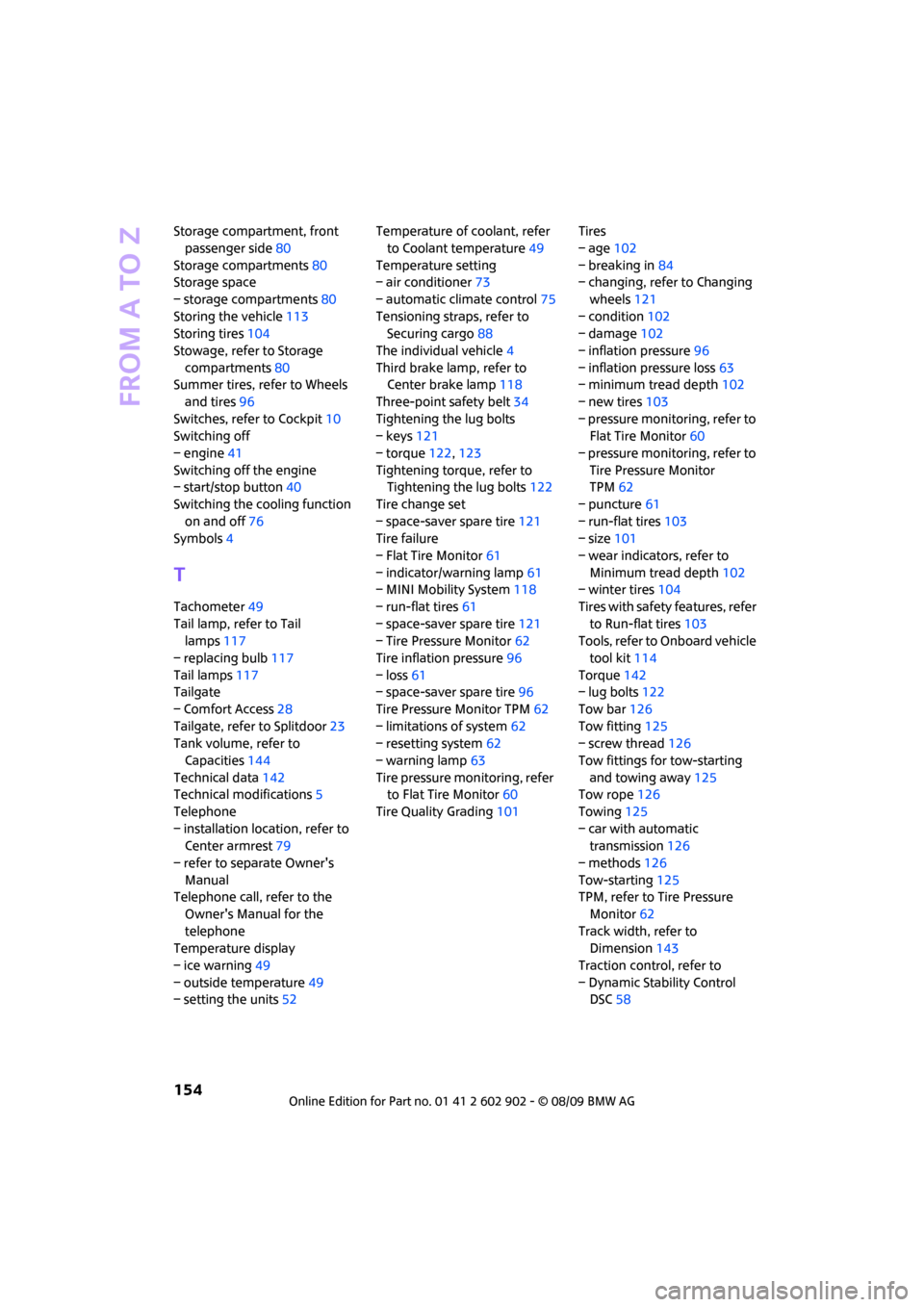
From A to Z
154
Storage compartment, front
passenger side80
Storage compartments80
Storage space
– storage compartments80
Storing the vehicle113
Storing tires104
Stowage, refer to Storage
compartments80
Summer tires, refer to Wheels
and tires96
Switches, refer to Cockpit10
Switching off
– engine41
Switching off the engine
– start/stop button40
Switching the cooling function
on and off76
Symbols4
T
Tachometer49
Tail lamp, refer to Tail
lamps117
– replacing bulb117
Tail lamps117
Tailgate
– Comfort Access28
Tailgate, refer to Splitdoor23
Tank volume, refer to
Capacities144
Technical data142
Technical modifications5
Telephone
– installation location, refer to
Center armrest79
– refer to separate Owner's
Manual
Telephone call, refer to the
Owner's Manual for the
telephone
Temperature display
– ice warning49
– outside temperature49
– setting the units52Temperature of coolant, refer
to Coolant temperature49
Temperature setting
– air conditioner73
– automatic climate control75
Tensioning straps, refer to
Securing cargo88
The individual vehicle4
Third brake lamp, refer to
Center brake lamp118
Three-point safety belt34
Tightening the lug bolts
– keys121
– torque122,123
Tightening torque, refer to
Tightening the lug bolts122
Tire change set
– space-saver spare tire121
Tire failure
– Flat Tire Monitor61
– indicator/warning lamp61
– MINI Mobility System118
– run-flat tires61
– space-saver spare tire121
– Tire Pressure Monitor62
Tire inflation pressure96
– loss61
– space-saver spare tire96
Tire Pressure Monitor TPM62
– limitations of system62
– resetting system62
– warning lamp63
Tire pressure monitoring, refer
to Flat Tire Monitor60
Tire Quality Grading101Tires
– age102
– breaking in
84
– changing, refer to Changing
wheels121
– condition102
– damage102
– inflation pressure96
– inflation pressure loss63
– minimum tread depth102
– new tires103
– pressure monitoring, refer to
Flat Tire Monitor60
– pressure monitoring, refer to
Tire Pressure Monitor
TPM62
– puncture61
– run-flat tires103
– size101
– wear indicators, refer to
Minimum tread depth102
– winter tires104
Tires with safety features, refer
to Run-flat tires103
Tools, refer to Onboard vehicle
tool kit114
Torque142
– lug bolts122
Tow bar126
Tow fitting125
– screw thread126
Tow fittings for tow-starting
and towing away125
Tow rope126
Towing125
– car with automatic
transmission126
– methods126
Tow-starting125
TPM, refer to Tire Pressure
Monitor62
Track width, refer to
Dimension143
Traction control, refer to
– Dynamic Stability Control
DSC58